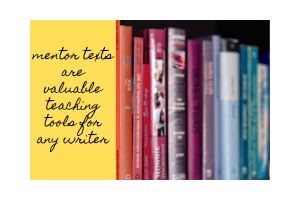I love having family and friends who teach at elementary schools for lots of reasons, but especially because of the opportunity to learn from them. One of the phrases I’ve heard but until recently was too shy to ask about was “mentor texts.” That phrase has flittered through a handful of conversations, usually when we are talking about children’s books we love.
Someone will say, “Oooh I love Kevin Henkes, I have used his books as mentor texts for using adjectives,” or “Bridge to Terabithia by Katherine Paterson is a perfect mentor text for teaching how to begin a story.” Teachers love using great books to spark a love of writing in children.
In her book Mentor Texts: Teaching Writing Through Children’s Literature, Lynne Dorfman describes mentor texts this way:
Mentor texts are pieces of literature that we can return to again and again as we help our young writers learn how to do what they may not yet be able to do on their own…. Mentor texts help writers to notice things about an author’s work that is not like anything they might have done before, and empower them to try something new.
In other words, mentor texts showcase the lovely ways authors wield words as building blocks to construct stories.
Mentor texts are a valuable learning technique not only for our youngest readers and writers, but it holds up well for us, er, older writers too.

In a recent SCBWI workshop on preparing your manuscript for submission, Deborah Warren of East West Literary Agency recommended utilizing mentor texts to help authors polish their own work. Here’s how she explained it: “If you’re struggling with dialogue, find a scene you think handles dialogue well, and study it. What makes it work? Why does it work? Deconstruct it and learn how that author does it. Then apply what you’ve learned to your manuscript.”
Notice that Ms. Warren does not instruct writers to “copy what you’ve read” from manuscripts. Instead, she encourages us to examine the elements of writing that resonate the most with us. She encourages us to become writing students and practice our craft, using pieces of literature to, as Dorfman says, empower us to try something new.
For example, if I have a scene that needs help establishing my setting, I might look at this paragraph from the opening of Sara Pennypacker’s Pax.
The fox felt the car slow before the boy did, as he felt everything first. Through the pads of his paws, along his spine, in the sensitive whiskers at his wrists. By the vibrations, he learned also that the road had grown coarser. He stretched up from his boy’s lap and sniffed at the threads of scent leaking in through the window, which told him they were not traveling into woodlands. The sharp odors of pine-wood, bark, cones, and needles-slivered through the air like blades, but beneath that, the fox recognized softer clover and wild garlic and ferns, and also a hundred things he had never encountered before…
I am excited to keep learning and growing in my craft by using mentor texts to help me revise and strengthen my manuscript. Have you worked with mentor texts before? How has it worked for you? Let me know in the comments.

Kell McKinney earned a B.A. in journalism from the University of Oklahoma and an M.S. in documentary studies from the University of North Texas. She’s a part-time copywriter, double-time mom and wife, and spends every free minute writing and/or hunting for her car keys. Connect with her on Twitter @Kell_McK or kellmckinney.com.




No Comments